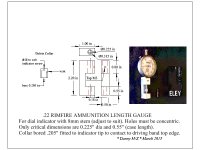Ok, website politics aside.
A few years ago I made a gauge to check from inside the the rim to the top driving band, just like Mr.Wass was referring to.
The results were very interesting and a few of my friends made one too as we agreed that the 'luxury' of precisely seating projectiles as with centrefire reloading was not possible with rimfire ammunition.
Sure we wasted a lot of time measuring rim thickness and weighing the ammo and soon reached the conclusion that the quality control of modern 'top shelf' rimfire ammunition is very good.
So further investigation revealed discrepancies between the distance between the inside of the rim and the driving band (effective length).
Using the gauge to batch decent rimfire ammunition (Eley Tenex) it soon became apparent that a few thousands of an inch in the 'working length' made a measurable difference to the impact point. Maybe because the 'jump' was different, who knows what this does to the pressure?
Not much, but it's the difference between a 9 and a 10.
I have attached a typical photo of the results. L= 0.002" longer than the average length, S= 0.002" View attachment 21764View attachment 21765" shorter than the average length (about 20% of a typical box of Eley Tenex)
In the tight match chamber of my ancient Annie '54 apparently length does make a difference. All targets were shot at 50m outdoors on a very calm day.
Just my observation from down under.
* Doggie *
doghunter,
Your gauge is most interesting. I would appreciate knowing how you control wax/lube build-up in the area of the driving band, when inserting and measuring each Tenex round? Would appreciate seeing a photo, or two, of what the chamber insert looks like in your gauge. Did you use a chamber reamer?
Yes, it might be a lot of work for the average person shooting in a local match, but if one was attending a national competition, it could be time well spent. Thanks for sharing. John



